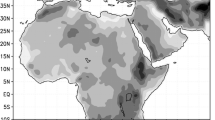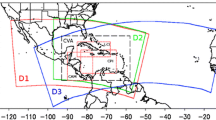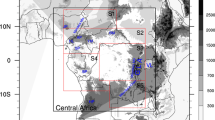Abstract
Results obtained with two versions of the Limited Area Model (LAM) ALADIN over differently sized integration domains (large, intermediate and small) in the European area are presented in order to investigate both the general model performance and the influence of domain choice on the quality of obtained results. The aim is also to illustrate the issues related to the strategy of selection of the optimal integration domain. Each of these studies has been performed with two versions of the ALADIN model: the first one is ALADIN-CLIMATE developed at CNRM/Météo-France, the second one is ALADIN-CLIMATE/CZ prepared at the Czech Hydrometeorological Institute (CHMI). This leaves us with total of six experiments forced by the European Centre for Medium-Range Weather Forecasts (ECMWF) ERA-40 reanalysis data. The west Balkan domain covering Bulgaria is used as an evaluation region for investigation of the temporal and spatial properties of simulated precipitation and temperature fields. This region has been selected for its challenging orography making the results obtained here a valuable source for studies leading to further developments in climate modeling. It was found that size of the domain strongly affects the quality of obtained results. We have found that the largest domain reproduces the spatial characteristics of climate (such as bias) very well, but its use results in a poor representation of temporal aspects, which are however captured very well in experiments over both smaller domains. Our findings suggest that there is no optimal choice of domain size, securing the best results for both spatial and temporal evaluation.
Our study also proves that model ALADIN can be efficiently used for climate research purposes, which together with its modest computational demands should make it as an attractive modeling choice for the Central and Eastern European climate research community.
Similar content being viewed by others

References
Bhaskaran B., Jones R.G., Murphy J.M. and Noguer M., 1996. Simulations of the Indian summer monsoon using a nested regional climate model: Domain size experiments. Clim. Dyn., 12, 573–587.
Bougeault P., 1985. A simple parameterization of the large-scale effects of cumulus convection. Mon. Weather Rev., 113, 2108–2121.
Bubnová R., Hello G., Bénard P. and Geleyn J.-F., 1995. Integration of the fully elastic equations cast in the hydrostatic pressure terrain-following coordinate in the framework of ARPEGE/Aladin NWP system. Mon. Weather Rev., 123, 515–535.
Davies H.C., 1976. A lateral boundary formulation for multi level prediction models. Q. J. R. Meteorol. Soc., 102, 405–418.
de Elia R., Plummer D., Caya D., Frigon A., Côté H., Giguère M., Paquin D., Biner S. and Harvey R., 2008. Evaluation of uncertainties in the CRCM-simulated North American climate: nesting-related issues. Clim. Dyn., 30, 113–132.
Déqué M., 2007. Frequency of precipitation and temperature extremes over France in an anthropogenic scenario: model results and statistical correction according to observed values. Glob. Planet. Change, 57, 16–26.
Dimitrijevic M. and Laprise R., 2005. Validation of the nesting technique in a regional climate model and sensitivity tests to the resolution of the lateral boundary conditions during summer. Clim. Dyn., 25, 550–580.
Douville H., Royer J.-F. and Mahfouf J.-F., 1995. A new snow parametrization for the Météo-France climate model. Part I: Validation in stand-alone experiments. Clim. Dyn., 12, 21–35.
Farda A., Štěpánek P., Halenka T., Skalák P. and Belda M., 2007. Model ALADIN in climate mode forced with ERA-40 reanalysis (coarse resolution experiment). Meteorological Journal, 10, 123–130.
Gerard L., 2001. Physical parameterizations in ARPÉGE-ALADIN operational model. ALADIN Documentation, Météo-France, 130 pp.
Hewitt C.D and Griggs D.J., 2004. Ensembles-based predictions of climate changes and their impacts. Eos Trans. AAGU, 85, 566.
Horányi A., Ihász I. and Radnóti G., 1996. ARPEGE/ALADIN: A numerical weather predicition model for Central-Europe with the participation of the Hungarian Meteorological Service. Időjárás, 100, 277–300.
Huth R., 2002. Statistical downscaling of daily temperature in central Europe. J. Climate, 15, 1731–1742.
Jacob D., Bärring L., Christensen O.B., Christensen J.H., de Castro M., Déqué M., Giorgi F., Hagemann S., Hirschi M., Jones R., Kjellström E., Lenderink G., Rockel B., Sànchez E.S., Schär C., Seneviratne S.I., Somot S., van Ulden A. and van den Hurk B., 2007. An intercomparison of regional climate models for Europe: Model performance in Present-Day Climate. Clim. Change, 81,Supplement 1, 31–52, doi: 10.1007/s10584-006-9213-4.
Janišková M., 1995. Study of the systematic errors in ALADIN associated to the physical part of the model. Note ALADIN n°7, CNRM, Météo-France, 82.
Jones R.G., Murphy J.M. and Noguer M., 1995. Simulation of climate change over Europe using a nested regional climate model. Part I: assessment of control climate, including sensitivity to location of lateral boundaries. Q. J. R. Meteorol. Soc., 121, 1413–1449.
Leduc M. and Laprise R., 2009. Regional climate model sensitivity to domain size. Clim. Dyn., 32, 833–854, doi: 10.1007/s00382-008-0400-z.
Lucas-Picher P., Caya D., de Elia R. and Laprise R., 2008. Investigation of regional climate models’ internal variability with a ten-member ensemble of ten years over a large domain. Clim. Dyn., 31, 927–940, doi: 10.1007/s00382-008-0384-8.
Malkmus W., 1967. Random Lorentz band model with exponential-tailed S-1 line-intensity distribution function. J. Opt. Soc. Am., 57, 323–329.
Mellor G.L. and Yamada T., 1982. Development of a turbulence closure model for geophysical fluid problems. Rev. Geophys. Space Phys., 20, 851–875.
Mitchell T.D., Carter T.R., Jones P.D., Hulme M. and New M., 2004. A comprehensive set of high-resolution grids of monthly climate for Europe and the globe: the observed record (1901–2000) and 16 scenarios (2001–2100). Tyndall Centre for Climate Change Research, Working Paper 55 (http://www.ipcc-data.org/docs/tyndall_working_papers_wp55.pdf).
Morcrette J.-J., 1989. Description of the Radiation Scheme in the ECMWF Model. Technical Memorandum 165, ECMWF, 26 pp.
Noilhan J. and Planton S., 1989. A simple parameterization of land surface processes for meteorological models. Mon. Weather Rev., 117, 536–549.
Radu R., Somot S. and Déqué M., 2008. Spectral nudging in a spectral regional climate model. Tellus Ser. A — Dyn. Meteorol. Oceanol., 60, 898–910.
Rauscher S.A., Seth A., Qian J.-H. and Camargo S.J., 2006. Domain choice in an experimental nested modeling prediction system for South America. Theor. Appl. Climatol., 86, 229–246.
Ricard J.-L. and Royer J.-F., 1993. A statistical cloud scheme for use in an AGCM. Ann. Geophys. — Atmos. Hydrosph. Space Sci., 11, 1095–1115.
Ritter B. and Geleyn J.-F., 1992. A comprehensive radiation scheme of numerical weather prediction with potential application to climate simulations. Mon. Weather Rev., 120, 303–325.
Sanchez-Gomez E., Somot S. and Déqué M., 2009. Ability of an ensemble of regional climate models to reproduce the weather regimes during the period 1961–2000. Clim. Dyn., 33, 723–736.
Taylor K.E., 2001. Summarizing multiple aspects of model performance in single diagram. J. Geophys. Research, 106(D7), 7183–7192.
Tegen I., Hollrig P., Chin M., Fung I., Jacob D. and Penner J., 1997. Contribution of different aerosol species to the global aerosol extinction optical thickness: estimates from model results. J. Geophys. Res., 102, 23895–23915.
Temperton C., Hortal M. and Simmons A.J., 2001. A two-time-level semi-Lagrangian global spectral model. Q. J. R. Meteorol. Soc., 127, 111–128.
Uppala S.M., Kållberg P.W., Simmons A.J., Andrae U., da Costa Bechtold V., Fiorino M., Gibson J.K., Haseler J., Hernandez A., Kelly, G.A., Li, X., Onogi K., Saarinen S., Sokka N., Allan R.P., Andersson E., Arpe K., Balmaseda M.A., Beljaars A.C.M., van de Berg L., Bidlot J., Bormann N., Caires S., Chevallier F., Dethof A., Dragosavac M., Fisher M., Fuentes M., Hagemann S., Hólm E., Hoskins B.J., Isaksen L., Janssen P.A.E.M., Jenne R., McNally A.P., Mahfouf J.-F., Morcrette J.-J., Rayner N.A., Saunders R.W., Simon P., Sterl A., Trenberth K.E., Untch A., Vasiljevic D., Viterbo P. and Woollen J., 2005. The ERA-40 re-analysis. Q. J. R. Meteorol. Soc., 131, 2961–3012.
Váña F., Benard P., Geleyn J.-F., Simon A. and Seity Y., 2008. Semi-Lagrangian advection scheme with controlled damping — an alternative way to nonlinear horizontal diffusion in a numerical weather prediction model. Accepted by Q. J. R. Meteorol. Soc., 134, 523–537.
von Storch H., Langenberg H. and Feser F., 2000. A spectral nudging technique for dynamical downscaling purposes. Mon. Weather Rev., 128, 3664–3673.
Wilby R.L., Wigley T.M.L., Conway D., Jones P.D., Hewitson B.C., Main J. and Wilks D.S., 1998. Statistical downscaling of general circulation model output, a comparison of Methods. Water Resour. Res., 34, 2995–3008.
Author information
Authors and Affiliations
Corresponding author
Rights and permissions
About this article
Cite this article
Farda, A., Déué, M., Somot, S. et al. Model ALADIN as regional climate model for Central and Eastern Europe. Stud Geophys Geod 54, 313–332 (2010). https://doi.org/10.1007/s11200-010-0017-7
Received:
Revised:
Accepted:
Published:
Issue Date:
DOI: https://doi.org/10.1007/s11200-010-0017-7



